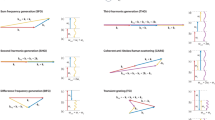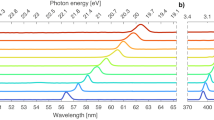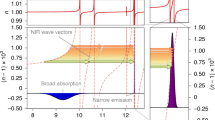Abstract
Four-wave mixing (FWM) processes, based on third-order nonlinear light–matter interactions, can combine ultrafast time resolution with energy and wavevector selectivity, and enable the exploration of dynamics inaccessible by linear methods1,2,3,4,5,6,7. The coherent and multi-wave nature of the FWM approach has been crucial in the development of advanced technologies, such as silicon photonics8, subwavelength imaging9 and quantum communications10. All these technologies operate at optical wavelengths, which limits the spatial resolution and does not allow the probing of excitations with energy in the electronvolt range. Extension to shorter wavelengths—that is, the extreme ultraviolet and soft-X-ray ranges—would allow the spatial resolution to be improved and the excitation energy range to be expanded, as well as enabling elemental selectivity to be achieved by exploiting core resonances5,6,7,11,12,13,14. So far, FWM applications at such wavelengths have been prevented by the absence of coherent sources of sufficient brightness and of suitable experimental set-ups. Here we show how transient gratings, generated by the interference of coherent extreme-ultraviolet pulses delivered by the FERMI free-electron laser15, can be used to stimulate FWM processes at suboptical wavelengths. Furthermore, we have demonstrated the possibility of observing the time evolution of the FWM signal, which shows the dynamics of coherent excitations as molecular vibrations. This result opens the way to FWM with nanometre spatial resolution and elemental selectivity, which, for example, would enable the investigation of charge-transfer dynamics5,6,7. The theoretical possibility of realizing these applications has already stimulated ongoing developments of free-electron lasers16,17,18,19,20: our results show that FWM at suboptical wavelengths is feasible, and we hope that they will enable advances in present and future photon sources.
This is a preview of subscription content, access via your institution
Access options
Subscribe to this journal
Receive 51 print issues and online access
$199.00 per year
only $3.90 per issue
Buy this article
- Purchase on Springer Link
- Instant access to full article PDF
Prices may be subject to local taxes which are calculated during checkout




Similar content being viewed by others
References
Bloembergen, N. Nonlinear optics and spectroscopy. Rev. Mod. Phys. 54, 685–695 (1982)
Boyd, W. R. Nonlinear Optics (Academic, 2008)
Dhar, L., Rogers, J. A. & Nelson, K. A. Time-resolved vibrational spectroscopy in the impulsive limit. Chem. Rev. 94, 157–193 (1994)
Cundiff, S. T. & Mukamel, S. Optical multidimensional coherent spectroscopy. Phys. Today 66, 44–49 (2013)
Bencivenga, F. et al. Multi-colour pulses from seeded free-electron-lasers: towards the development of non-linear core-level coherent spectroscopies. Faraday Discuss. 171, 487–503 (2014)
Bencivenga, F. et al. Nanoscale dynamics by short-wavelength four wave mixing experiments. New J. Phys. 15, 123023 (2013)
Tanaka, S. & Mukamel, S. Coherent X-ray Raman spectroscopy: a nonlinear local probe for electronic excitations. Phys. Rev. Lett. 89, 043001 (2002)
Foster, M. A. et al. Broad-band optical parametric gain on a silicon photonic chip. Nature 441, 960–963 (2006)
Chen, P.-Y. & Al, A. Subwavelength imaging using phase-conjugating nonlinear nanoantenna arrays. Nano Lett. 11, 5514–5518 (2011)
Boyer, V., Marino, A. M., Pooser, R. C. & Lett, P. D. Entangled images from four-wave mixing. Science 321, 544–547 (2008)
Tanaka, S., Chernyak, V. & Mukamel, S. Time-resolved X-ray spectroscopies: nonlinear response functions and Liouville-space pathways. Phys. Rev. A 63, 063405 (2001)
Adams, B. Nonlinear X-ray optics: the next phase for X-rays. Nature Phys. 7, 675–676 (2011)
Glover, T. E. et al. X-ray and optical wave mixing. Nature 488, 603–608 (2012)
Tamasaku, K., Sawada, K., Nishiboro, E. & Ishikawa, T. Visualizing the local optical response to extreme ultraviolet radiation with a resolution of λ/380. Nature Phys. 7, 705–708 (2011)
Allaria, E. et al. Highly coherent and stable pulses from the FERMI seeded free-electron laser in the extreme ultraviolet. Nature Photon. 6, 699–704 (2012)
Allaria, E. et al. Two-colour pump-probe experiments with a twin pulse-seed extreme ultraviolet free-electron laser. Nature Commun. 4, 2476 (2013)
Lutman, A. A. et al. Experimental demonstration of femtosecond two-color X-ray free-electron-lasers. Phys. Rev. Lett. 110, 134801 (2013)
Hara, T. et al. Two-colour hard X-ray free-electron laser with wide tunability. Nature Commun. 4, 2919 (2013)
Lutman, A. A. et al. Demonstration of single-crystal self-seeded two-color X-ray free-electron lasers. Phys. Rev. Lett. 113, 254801 (2014)
Marcus, G., Penn, G. & Zholents, A. A. Free-electron laser design for four-wave-mixing experiments with soft X-ray pulses. Phys. Rev. Lett. 113, 024801 (2014)
Bencivenga, F. & Masciovecchio, C. FEL-based transient grating spectroscopy to investigate nanoscale dynamics. Nucl. Instrum. Methods A 606, 785–789 (2009)
Shwartz, S. et al. X-ray second harmonic generation. Phys. Rev. Lett. 112, 163901 (2014)
Rohringer, N. et al. Atomic inner-shell X-ray laser at 1.46 nanometres pumped by an X-ray free-electron laser. Nature 481, 488–491 (2012)
Beye, M. et al. Stimulated X-ray emission for materials science. Nature 501, 191–194 (2013)
Tamasaku, K. et al. X-ray two-photon absorption competing against single and sequential multiphoton processes. Nature Photon. 8, 313–316 (2014)
Armstrong, J. A., Bloembergen, N., Ducuing, J. & Pershan, P. S. Interactions between light waves in a nonlinear dielectric. Phys. Rev. 127, 1918–1939 (1962)
Tobey, R. I. et al. Transient grating measurement of surface acoustic waves in thin metal films with extreme ultraviolet radiation. Appl. Phys. Lett. 89, 091108 (2006)
Sistrunk, E. F. et al. Extreme ultraviolet transient grating measurement of insulator-metal transition dynamics of VO2. In 19th International Conference on Ultrafast Phenomenahttp://dx.doi.org/10.1364/UP.2014.09.Wed.P3.44 (Paper 09.Wed.P3.44, Optical Society of America, 2014)
Schirmacher, W. et al. Vibrational excitations in systems with correlated disorder. Phys. Status Solidi C 5, 862–866 (2008)
Ferrante, C. et al. Acoustic dynamics of network-forming glasses at mesoscopic wavelengths. Nature Commun. 4, 1793 (2013)
Capotondi, F. et al. Coherent imaging using seeded free-electron laser pulses with variable polarization: first results and research opportunities. Rev. Sci. Instrum. 84, 051301 (2013)
Zangrando, M. et al. The photon analysis, delivery, and reduction system at the FERMI@Elettra free electron laser user facility Rev. Sci. Instrum. 80, 113110 (2009)
Cucini, R., Bencivenga, F., Zangrando, M. & Masciovecchio, C. Technical advances of the TIMER project. Nucl. Instrum. Methods A 635, S69–S74 (2011)
Cucini, R., Bencivenga, F. & Masciovecchio, C. All-reflective femtosecond optical pump-probe setup for transient grating spectroscopy. Opt. Lett. 36, 1032–1034 (2011)
Allaria, A. et al. Tunability experiments at the FERMI@Elettra free-electron laser New J. Phys. 14, 113009 (2012)
Danailov, M. B. et al. Towards jitter-free pump-probe measurements at seeded free electron laser facilities. Opt. Express 22, 12869–12879 (2014)
Cinquegrana, P. et al. Optical beam transport to remote location for low jitter pump-probe experiments with free electron laser. Phys. Rev. ST Accel. Beams 17, 040702 (2014)
Gahl, C. et al. A femtosecond X-ray/optical cross-correlator. Nature Photon. 2, 165–169 (2008)
Casolari, F. et al. Role of multilayer-like interference effects on the transient optical response of Si3N4 films pumped with free-electron laser pulses. Appl. Phys. Lett. 104, 191104 (2014)
Ruhman, S., Joly, A. G. & Nelson, K. A. Time resolved observations of coherent molecular vibrational motion and the general occurrence of impulsive stimulated scattering. J. Chem. Phys. 86, 6563–6565 (1987)
Kalampounias, A. G., Yannopoulos, S. N. & Papatheodorou, G. N. Temperature-induced structural changes in glassy, supercooled, and molten silica from 77 to 2150 K. J. Chem. Phys. 124, 014504 (2006)
Hehlen, B. et al. Hyper-Raman scattering observation of the boson peak in vitreous silica. Phys. Rev. Lett. 84, 5355–5358 (2000)
Buchenau, U., Nucker, N. & Dianoux, A. J. Neutron scattering study of the low-frequency vibrations in vitreous silica. Phys. Rev. Lett. 53, 2316–2319 (1984)
Acknowledgements
We acknowledge support from the Italian Ministry of University and Research through grants FIRB-RBAP045JF2 and FIRB-RBAP06AWK3, and from the European Research Council through grant 202804-TIMER. We thank M. Svandrlik and the FERMI-FEL team for support.
Author information
Authors and Affiliations
Contributions
C.M. proposed and led the project to extend transient grating methods at suboptical wavelengths. F.B. conceived the experiment and coordinated all activities. F. Capotondi designed the set-up to split and recombine the FEL pulses. A.G. realized the set-up and, together with F. Capotondi, A.B. and R.M., integrated it into the end-station. F.B., R.C., A.B., A.G. and R.M. tested the set-up. I.P.N. and M.B.D. realized the set-up to control the optical pulse. F.B., R.C., F. Capotondi, A.B., R.M., E.G., M.M., E.P., E.P., C.S. and F. Casolari performed the experiment. A.B., R.M., F.B., R.C., F. Capotondi and M.M. carried out the data analysis. P.P., C.S., A.B. and R.M. performed the AFM measurements and analysis. F.B., R.C., F. Capotondi, A.B., M.B.D., M.K. and C.M. discussed the data. F.B. and C.M. prepared the manuscript.
Corresponding authors
Ethics declarations
Competing interests
The authors declare no competing financial interests.
Extended data figures and tables
Extended Data Figure 1 Experimental set-up for FEL-based FWM measurements.
a, Top-view layout of the experimental set-up used to split and recombine the FEL beams. b, Top-view layout of the experimental set-up used to control the optical beam. c, Top-view picture of the set-up: the two FEL paths (FP1 and FP2) downstream of M1 and the trajectory of the optical pulse are indicated. d, Sketch of the movements needed to change 2θ keeping ΔtEUV-EUV fixed. e, Sketch of the movements needed to change ΔtEUV-EUV keeping 2θ fixed. See Methods for details of a–e. f, g, Optical reflectivity changes in Si3N4 induced by the FEL beam propagating through FP1 (green dots) and FP2 (magenta dots). In f, the mirrors were displaced with respect to the nominal position; a poor time coincidence and a different fluence level in the interaction region can be seen. g, Same measurements as in f after optimization of the geometry; the superposition of the two traces indicates a large improvement in the time coincidence and a similar FEL fluence in the interaction region.
Extended Data Figure 2 AFM topographies.
AFM topographies of 8 × 8 μm2 areas of the sample surface as follows: in a region that was not irradiated (a), in an area irradiated by ∼300 FEL shots at a fluence larger than 50 mJ cm−2 (b), and in an area continuously irradiated by FEL pulses at low fluence (c). d–f, Representative depth profiles of the sample surface along the green lines shown in a–c, respectively. The power spectral densities (PSD) corresponding to data reported in d–f are shown in g–i, respectively.
Extended Data Figure 3 Time sequence of acquired data.
Black open and crossed circles connected by lines are data shown in Fig. 3; crossed circles correspond to a scan made several hours after the one corresponding to data shown as open circles; in both scans the time delay was continuously increased. Green dots are data collected before these two scans; here we had not yet optimized the FWM signal at Δt = 0 (these data are scaled by a factor to fit the peak intensity of the data shown as black circles). Blue and red lines are the same as shown in Fig. 3.
Source data
Rights and permissions
About this article
Cite this article
Bencivenga, F., Cucini, R., Capotondi, F. et al. Four-wave mixing experiments with extreme ultraviolet transient gratings. Nature 520, 205–208 (2015). https://doi.org/10.1038/nature14341
Received:
Accepted:
Issue Date:
DOI: https://doi.org/10.1038/nature14341
This article is cited by
-
Transient responses of double core-holes generation in all-attosecond pump-probe spectroscopy
Scientific Reports (2024)
-
A high-efficiency programmable modulator for extreme ultraviolet light with nanometre feature size based on an electronic phase transition
Nature Photonics (2024)
-
The Dynamics on Soliton Molecules and Soliton Bifurcation for an Extended Generalization of Vakhnenko Equation
Qualitative Theory of Dynamical Systems (2024)
-
Progress and prospects in nonlinear extreme-ultraviolet and X-ray optics and spectroscopy
Nature Reviews Physics (2023)
-
Transient gratings with X-rays
Nature Photonics (2021)
Comments
By submitting a comment you agree to abide by our Terms and Community Guidelines. If you find something abusive or that does not comply with our terms or guidelines please flag it as inappropriate.



